|
In 1953 the company decided to enter three
machines in the Isle of Man T.T. They were to be powered
by a special engine, a 250cc twin, with a rotating combustion
chamber head, capable of developing around 28bhp. Six T.T. frame sets with trailing link
front suspension, and front and rear oscillating brakes were
built in preparation. Three machines were to be entered in the
T.T. Two top riders, Ray Amm and Bill Doran were
interested in riding the machines, but although a working
prototype engine was built and tested, the project had to be
cancelled due to a lack of
finance. (Thanks must go to Martin Tiller for supplying the information).
|
|
|

A DMW 'Cortina' |
Several new machines were introduced in 1954,
including the ‘Cortina’, a name later used by Ford. It was named
after the Italian resort in the Dolomite mountains where Harold
Nock had a winter holiday.
Much thought was given to the styling
of the ‘Cortina’, a luxurious lightweight machine, powered by the new 225c.c. Villiers 1H engine.
It had a
'P'-type frame, made from square section tubing, and pressed
steel panels with internal compartments for the battery and
toolkit.
The panels continued towards the rear to form a deeply valanced mudguard for the rear wheel. |
| The heavily valanced front mudguard gave good protection from debris thrown up from wet roads.
The machine had an enclosed chain drive and a hydraulically damped rear
suspension. The Metal Profiles front fork had a neat cover on
the top to house the headlamp, speedometer, ammeter and light
switch.
There was a dual seat for the rider and a pillion
passenger, which could be raised to give access to the battery,
rectifier and twin tool compartments.
The machine was finished
in turquoise blue, Paris grey or black, with a gold-lined petrol
tank.
The wheel rims were chrome plated. |
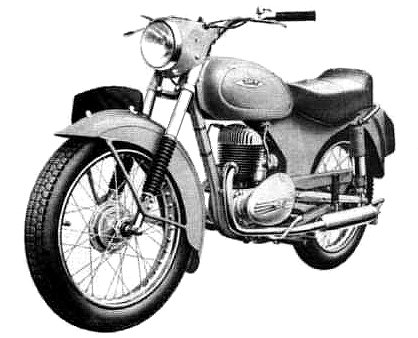
The 200P Mark 1 was a cheaper version of
the 'Cortina'. It had a similar specification,
and was powered by a 197c.c. Villiers 8E/3 engine. |
|

Gemma Toon's 200P Mark 1. |
‘The Motor Cycle’ magazine conducted a road test for the 17th
February, 1955 edition.
The ‘Cortina’ was described as having the
handiness of a lightweight and the sturdiness of construction
normally associated with a heavier machine.
It not only steered
and handled well, but also possessed considerable powers of
acceleration.
The top speed was around 60m.p.h., with a fuel
consumption of around 71m.p.g. at 50m.p.h. |
|
The DMW 'Dolomite' on display at the
National Motorcycle Museum.
Courtesy of Jo Skidmore. |
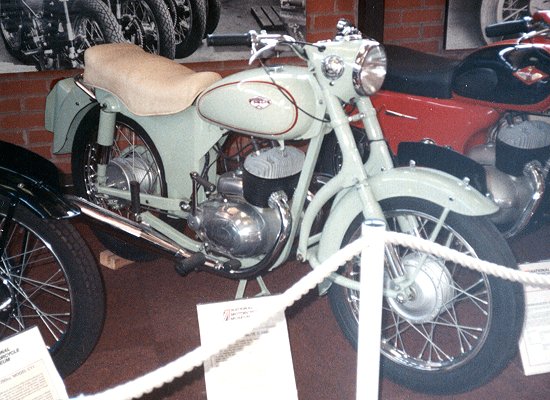 |
| The ‘Dolomite’, a development of the ‘Cortina’ was launched in 1954. It had Metal Profiles ‘Earles’ type front
forks and an electric starter using the Siba Dynastart system.
The top speed was around 72m.p.h. It sold for £240. |
|
In 1953 DMW decided to develop a de luxe road
model, powered by the new Villiers 250c.c. vertical twin
two-stroke engine. Unfortunately Associated Motor Cycles wanted
the engine for their own exclusive use, and Villiers agreed.
In
response to this Harold Nock sent works manager Arthur Frost,
across to France. He returned with some good looking overhead
camshaft engine and gearbox units, which were built by Ateliers Mechanique du Centre, ironically with the same initials as
Associated Motor Cycles.
The French AMC engines had a single
camshaft, and several versions were available. There were
170c.c. and 249c.c. models, and a 125c.c. racing unit that was used to power
the DMW ‘Hornet’. The machine was launched in 1954, and like the ‘Dolomite’
had Metal Profiles ‘Earles’ type forks. It was
listed at £362.10s.0d. |
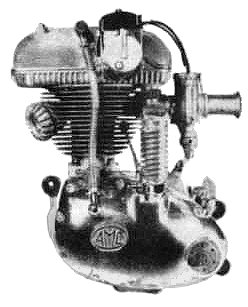
The French 125c.c. AMC engine.
|
 |
View some DMW
machines from the 1950s |
| In the late 1950s motor scooters were very popular,
and in response to this, DMW launched the ‘Bambi’. Prototypes
were first shown in 1950. The scooter was constructed
from steel pressings and had large disc wheels. |
|
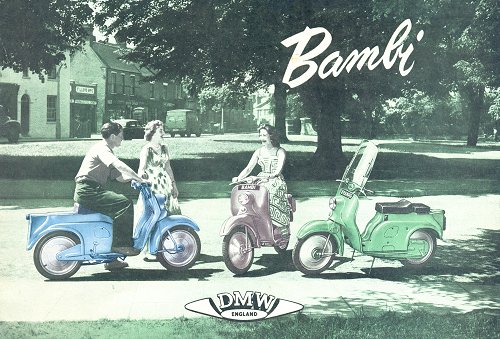
DMW 'Bambi' motor scooters. |
It was powered by a 98c.c. Villiers 4F two-stroke
engine with an integral 2-speed
gearbox.
The scooter had a top speed of 35m.p.h. and an
average fuel consumption of 135m.p.g.
The machine went into production in 1957 and sold
for £110.8s.0d. About 500 were produced. |
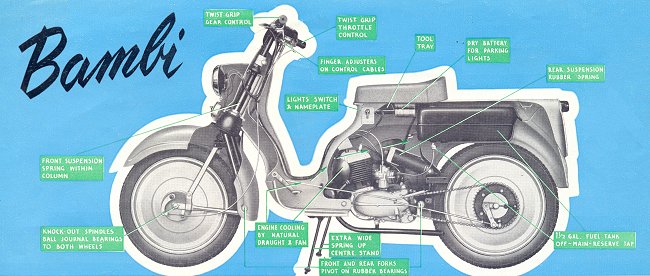

The 'Bambi' specification.
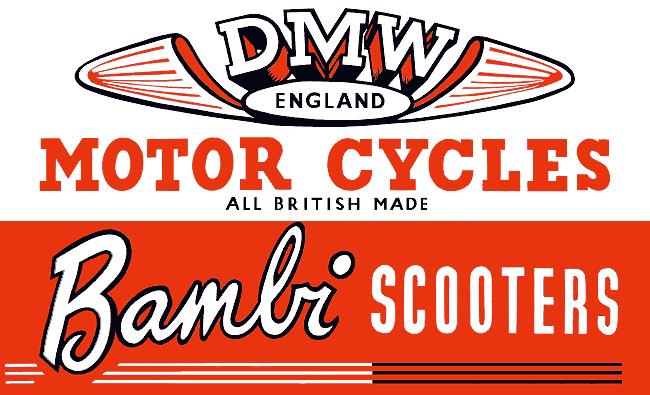
An advertising sign. Courtesy of Brian
Shaw.
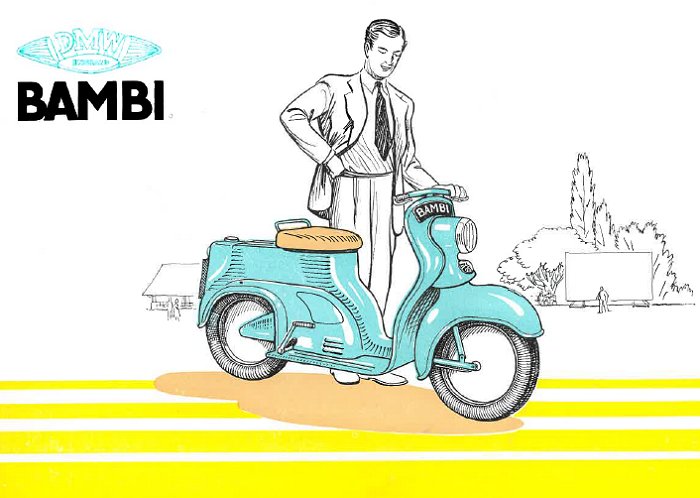
The front page of a 'Bambi' catalogue.
Courtesy of Brian Shaw.

The back page of the 'Bambi' catalogue.
Courtesy of Brian Shaw.
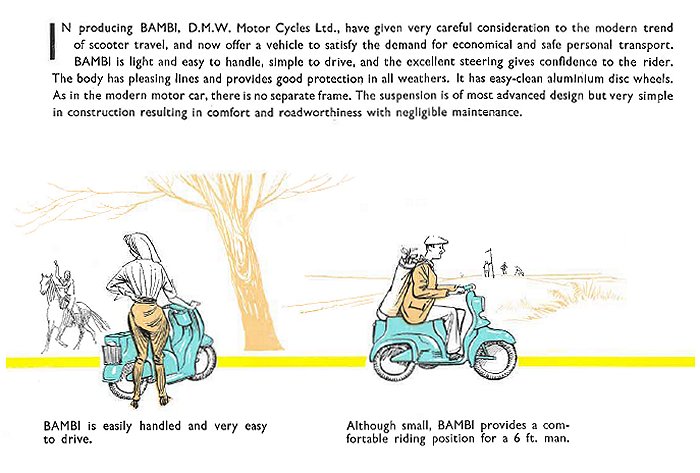
One of the inside pages from the 'Bambi'
catalogue. Courtesy of Brian Shaw.

Another image from the 'Bambi' catalogue.
Courtesy of Brian Shaw.
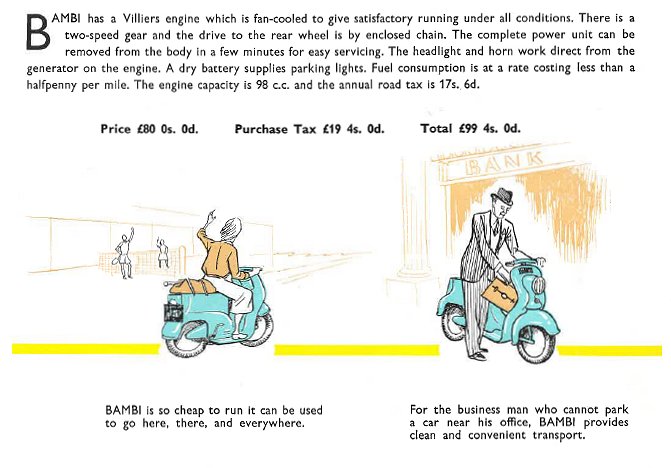
A final image from the 'Bambi' catalogue.
Courtesy of Brian Shaw.
| |
|
| View the Bambi
specification and service details |
 |
| |
|
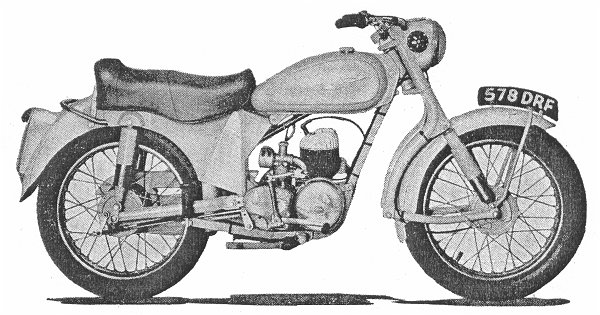
A 147 c.c. 2-stroke D.M.W. 'Leda'.

The 'Leda' specification.
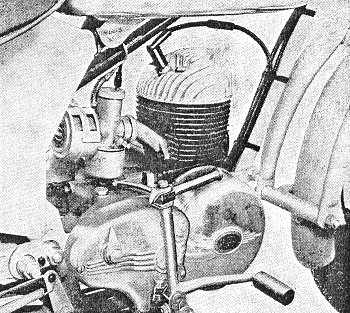
The Villiers 29C engine, with
a built-in 4-speed gearbox that was used in the
'Leda'.
The photo
opposite shows a 'Leda' in action. |
|
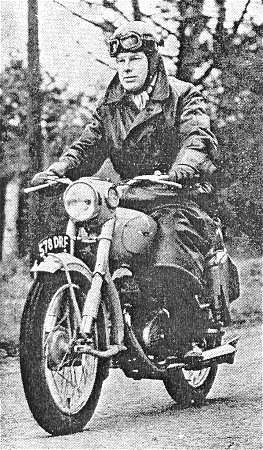 |
| The 1957 Motor Cycle Show saw the only appearance
of the DMW 'Dumbo', which was a cross between a motor cycle and
a scooter. Possibly only a single prototype was built.
A similar
model, the 'Deemster', also a cross between a motorcycle and
scooter, was launched in 1962. It had a Villiers
249c.c. twin-cylinder two- stroke engine, with electric or kick
start, and like the 'Bambi' was built around a number of steel
pressings. There were Standard and DeLuxe models, which were fitted with a Villiers 4-speed gearbox. The DeLuxe version included
a Siba Dynastart electric starter.
The engine and fuel tank were
mounted following normal motorcycle practice, and there were
removable rear side panels and floorboards. It had built-in leg shields and a large
comfortable seat, a large locker, a windscreen, and twin 5 inch
headlamps. There were 12 inch disc wheels, with a brake of DMW's
own design using a Girling patent. The frame was robust, with a
large diameter spine, joined to a square section down tube, and
a framework of angle and tube supports for the
footboards and sides. It was fitted with 'Earles' type front forks with a Girling damper on one side. |
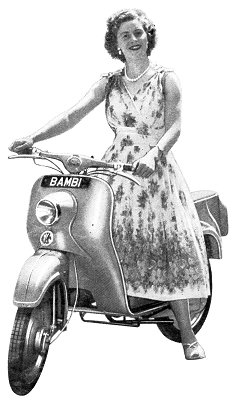
From the 'Bambi' sales
literature. |
|
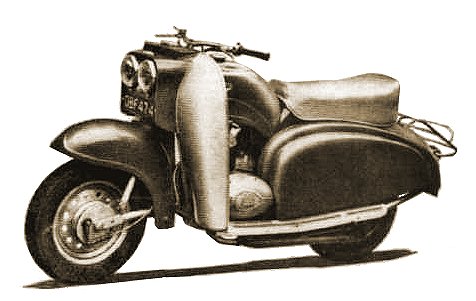
The 'Deemster'. |
The machine was never popular with the general public, but was very
successful in the rural police service.
A number of police forces
used them including Wolverhampton, which had eight.
The Police
versions were equipped with a radio and a blue flashing light.
The
selling price to the general public was £380. |
|
|
|
 |
View some
photographs of
Deemsters |
|
|
|
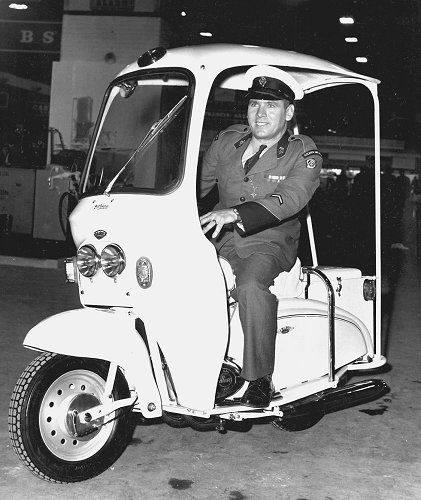 |
One of the covered Deemsters being
ridden by a Colwyn Bay AA patrolman. Although developed for
the police, it seems that they had other uses.
Courtesy of Brian Shaw. |
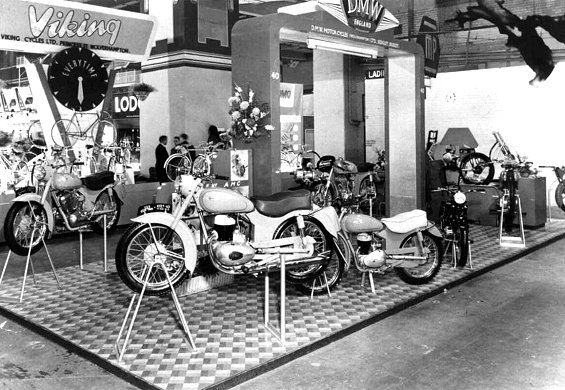
A DMW display at a show in 1954 or 1955. Courtesy of
Jo Skidmore
| This fine Dolomite from
1960 is owned by Arthur Stubbs, of Hatton, Derbyshire.
The photograph was taken at the
Festival of Black
Country Vehicles that was held at the Black Country
Living Museum, Dudley, on 26th July, 2009. |
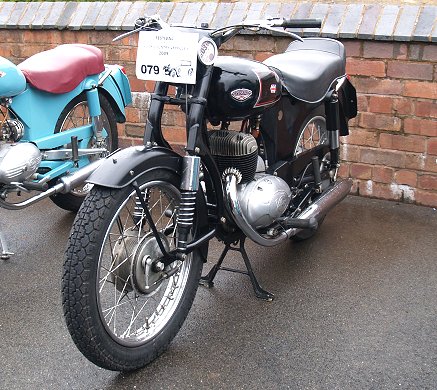 |
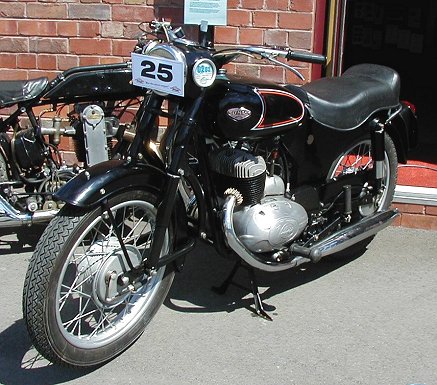 |
Another view of Arthur
Stubbs' excellent machine, which he restored himself. |
|

Courtesy of René
Krullaars. |
| Mick Knowles' 200P. |
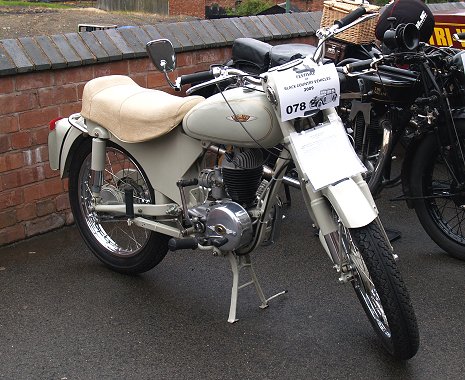 |
|
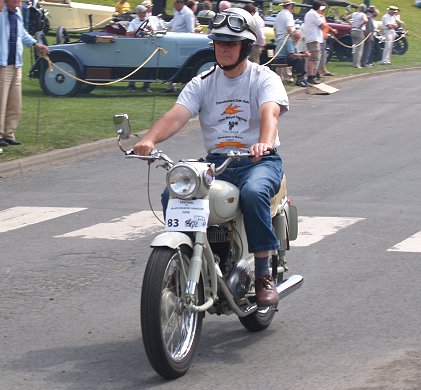
Mick Knowles riding his 200P at the
annual Festival of Black Country Vehicles which is held at
the Black Country Living Museum. |
In 1962 Harold Nock purchased Ambassador Motor
Cycles of Ascot and moved production to Sedgley.
Ambassador Motor Cycles was one of several companies
owned by the famous record breaker Kaye Don, who drove the
Sunbeam Silver Bullet in 1930.
Ambassador
motorcycles were produced in Sedgley from July 1963 until September
1965, but they were mainly 'badged' DMW 'Dolomite II'
machines. |
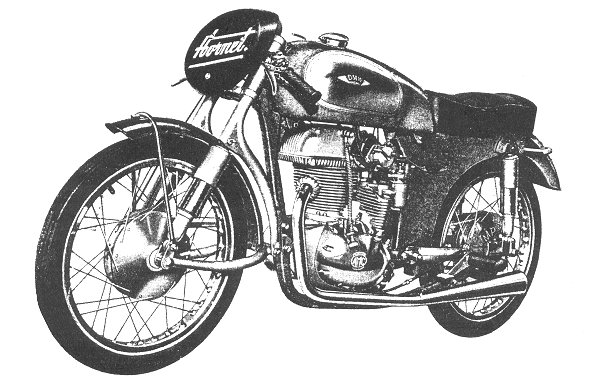
The 'Hornet' from the company's advertising
literature. Courtesy of the late Jim Boulton.
|
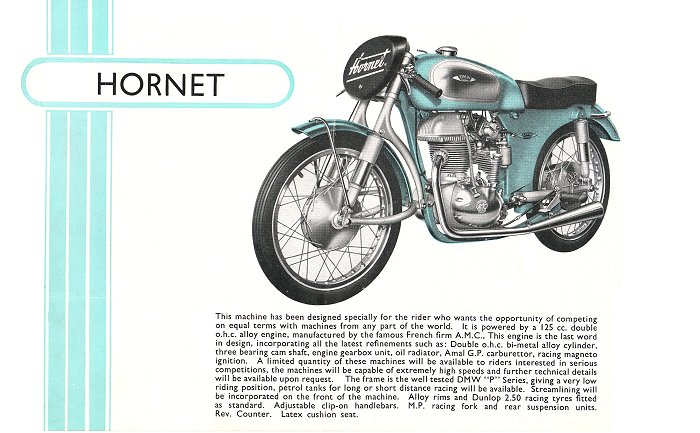
Courtesy of René Krullaars. |
| In the middle of 1963, Villiers adapted the engine for
installation in the Bond three wheeler. In order to solve
cooling problems, the top half of the engine was redesigned
to allow a greater passage of cooling air. The modified
engine was called the Mark 4T. |
| The new engine did not work very well in the 'Deemster'. It
was not as powerful as its predecessor at slow speeds, and the smooth running of the
original engine had gone.
The new engine was totally unsuitable for
police work. A redesign was necessary.
Initially a 197c.c. single cylinder Villiers engine was tried and then
the 250c.c. horizontally-opposed twin cylinder engine and running gear,
as fitted to the Velocette 'Viceroy' scooter. The new version appeared
in 1968 but was unsuccessful due to starting problems and high
maintenance costs. Only about 100 were sold to the general public and
about 250 to the police. |

Gemma Toon's 1964 'Hornet'. |

 |
|
 |
|
 |
|
Return to
Into Production |
|
Return to
the
beginning |
|
Proceed to
More Machines |
|